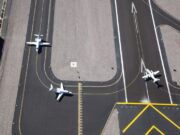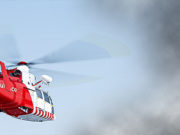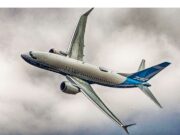
Western-built commercial jets were involved in 29 accidents in 2014, down from 31 the previous year, but the number of fatalities more than quadrupled to 279, up from 62 in 2013 (Table 1 [opens table in new tab]), according to data from Boeing Commercial Airplanes.1,2
In its annual Statistical Summary of Commercial Jet Airplane Accidents, published in August, Boeing noted three fatal accidents, two of which killed a total of 278 people — everyone in both airplanes. In the third accident, a Boeing 737 landing in Libreville, Gabon, struck and killed a person on a runway; all 137 passengers and crewmembers survived.
Malaysia Airlines Flight 370, a Boeing 777 that disappeared during a March 8 flight from Kuala Lumpur, Malaysia, to Beijing with 239 people aboard, did not meet Boeing’s definition of an accident and was not included on the list.3 Debris from the 777 has washed ashore on Réunion Island, but the main wreckage has not been found.
The 2014 fatality count of 279 compared with an annual average of 399 over the previous 10-year period (from 2004 through 2013), Boeing said.
Of the 29 accidents, Boeing classified three as major — a classification that means “the airplane was destroyed, [or] there were multiple fatalities, [or] there was one fatality and the airplane was substantially damaged.” Ten accidents were considered hull loss accidents — accidents in which an airplane is “totally destroyed or damaged and not repaired” — compared with a 10-year average of 17 per year.
During the most recent 10-year period, from 2005 through 2014, there were 404 accidents, including 165 hull loss accidents and 72 fatal accidents that killed 3,946 passengers and crewmembers and 139 people on the ground, Boeing said (Table 2).
| Type of operation | All Accidents | Fatal Accidents | On-board Fatalities (External Fatalities)* |
Hull Loss Accidents | ||||
|---|---|---|---|---|---|---|---|---|
| 1959–2014 | 2005–2014 | 1959–2014 | 2005–2014 | 1959–2014 | 2005–2014 | 1959–2014 | 2005–2014 | |
| *External fatalities include ground fatalities and fatalities on other aircraft involved, such as helicopters or small general aviation airplanes, that are excluded.
Source: Boeing Commercial Airplanes |
||||||||
| Passenger | 1,501 | 327 | 493 | 56 | 29,165 (792) | 3,888 (124) | 704 | 118 |
| Scheduled | 1,380 | 302 | 447 | 53 | 25,039 | 3,872 | 634 | 111 |
| Charter | 121 | 25 | 46 | 3 | 4,126 | 16 | 70 | 7 |
| Cargo | 265 | 65 | 79 | 13 | 273 (342) | 41 (15) | 178 | 39 |
| Maintenance test, ferry, positioning, training and demonstration | 124 | 12 | 44 | 3 | 208 (66) | 17 (0) | 76 | 8 |
| Totals | 1,890 | 404 | 616 | 72 | 29,646 (1,200) | 3,946 (139) | 958 | 165 |
| U.S. and Canadian operators | 564 | 75 | 182 | 12 | 6,202 (381) | 26 (7) | 227 | 25 |
| Rest of the world | 1,326 | 329 | 434 | 60 | 23,444 (819) | 3,920 (132) | 731 | 140 |
| Totals | 1,890 | 404 | 616 | 72 | 29,646 (1,200) | 3,946 (139) | 956 | 165 |
The data showed that the accident rate for that period was 0.73 per million departures, and the fatal accident rate, 0.32 per million departures (Figure 1). For scheduled commercial passenger operations, the rates were slightly lower — 0.58 accidents and 0.28 fatal accidents per million departures.
Figure 1 — 10-Year Accident Rates, by Type of Operation, Worldwide Commercial Jet Fleet, 2005–2014
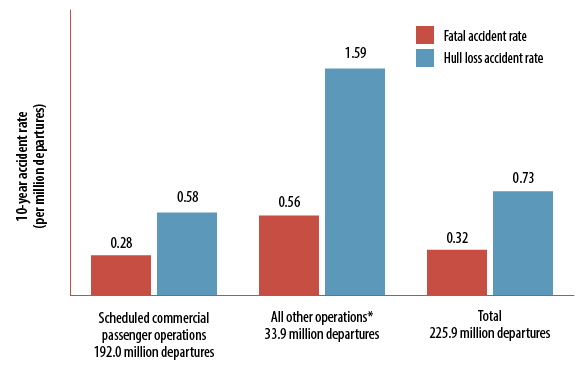
* Charter passenger, charter cargo, scheduled cargo, maintenance test, ferry, positioning, training and demonstration flights.
Source: Boeing Commercial Airplanes
From the time Boeing’s data collection began in 1959 through 2014, there were 1,890 accidents, including 958 hull losses and 616 fatal accidents (Figure 2).
Figure 2 — Accidents, Worldwide Commercial Jet Fleet, by Type of Operation
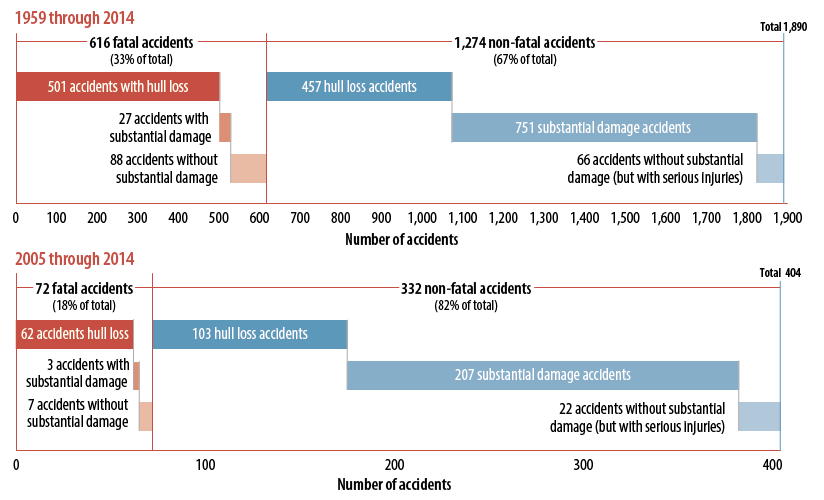
*External fatalities include ground fatalities and fatalities on other aircraft involved, such as helicopters or small general aviation airplanes, that are excluded.
Source: Boeing Commercial Airplanes
Breaking down accidents according to terminology developed by the U.S. Commercial Aviation Safety Team (CAST) and the International Civil Aviation Organization (ICAO), the data showed that 17 accidents from 2005 through 2014 resulted from loss of control–in flight — a greater number than were attributed to any other cause (Figure 3). Sixteen accidents each were attributed to controlled flight into terrain and to runway excursions on landing — a category that includes the subcategories of abnormal runway contact and undershoot/overshoot. Six additional runway excursion accidents occurred during takeoff, the report said.
Figure 3 — Fatalities by CAST/ICAO Taxonomy Accident Category, Worldwide Commercial Jet Fleet, 2005–2014
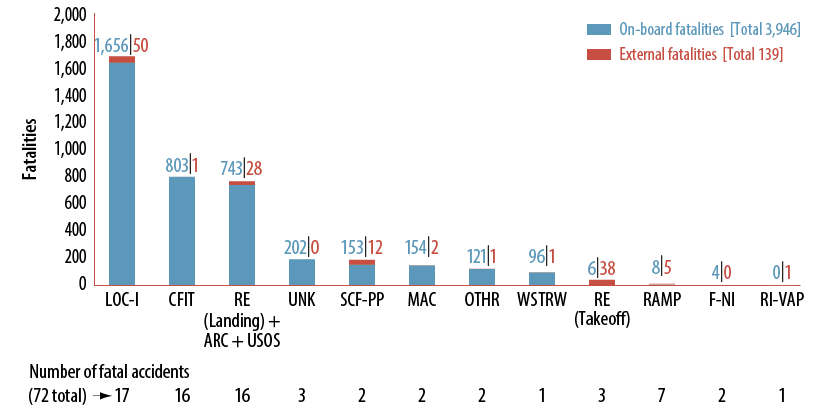
CAST = U.S. Commercial Aviation Safety Team; ICAO = International Civil Aviation Organization; ARC = abnormal runway contact; CFIT = controlled flight into terrain; F-NI = fire/smoke (non-impact); LOC-I = loss of control – in flight; MAC = midair/near-midair collision; OTHR = other; RAMP = ground handling; RE = runway excursion; RI-VAP = runway incursion – vehicle, aircraft or person; SCF-PP = system/component failure or malfunction (powerplant); UNK = unknown or undetermined; USOS = undershoot/overshoot; WSTRW = wind shear or thunderstorm
No accidents were noted in the following principal categories: aerodrome; abrupt maneuver; air traffic management/communications, navigation, surveillance; bird strikes; cabin safety events; evacuation; external load-related occurrences; fire/smoke (post-impact); fuel related; ground collision; icing; low altitude operations; loss of control – ground; runway incursion – animal; security related; system/component failure or malfunction (non‑powerplant); turbulence encounter; wildlife.
Note: Principal categories are as assigned by CAST. Airplanes manufactured in the Commonwealth of Independent States or the Soviet Union are excluded because of lack of operational data. Commercial airplanes used in military service are also excluded.
Source: Boeing Commercial Airplanes
The data also showed that, in 2005 through 2014, nearly half of all fatal accidents occurred during final approach and landing — significantly more than any other phases of flight. Seventeen fatal accidents (24 percent) during that period occurred during final approach, and another 17 occurred during landing, the report said. Nine fatal accidents (13 percent) occurred during cruise flight.
During the same time frame, more on-board fatalities occurred in fatal crashes during cruise than in any other phase of flight, the report said. Data showed that 1,052 people (27 percent) were killed in those accidents, 848 (21 percent) were killed in accidents during final approach, and 681 (17 percent) were killed in landing accidents.
Western-built commercial jets have flown 1.26 billion flight hours — or 686 million departures — since Boeing began collecting data in 1959, the report said. In 2014 alone, flight hours totaled 56.5 million, and departures totaled 25.6 million.
Notes
- Boeing Commercial Airplanes. Statistical Summary of Commercial Jet Airplane Accidents: Worldwide Operations 1959–2014. August 2015. <www.boeing.com/news/techissues/pdf/statsum.pdf>.
- The data include commercial jet airplanes with maximum gross weight of more than 60,000 lb (27,217 kg). Airplanes manufactured in the Commonwealth of Independent States or the Soviet Union are excluded because of insufficient operational data. Also excluded are commercial airplanes in military service and those in events involving military action, sabotage and terrorism.
- Boeing defines an accident as “an occurrence associated with the operation of an airplane that takes place between the time any person boards the airplane with the intention of flight and such time as all such persons have disembarked, in which: The airplane sustains substantial damage; the airplane is missing or is completely inaccessible (an aircraft is considered to be missing when the official search has been terminated and the wreckage has not been located); death or serious injury results from being in the airplane, direct contact with the airplane or anything attached thereto [or] direct exposure to jet blast.”
